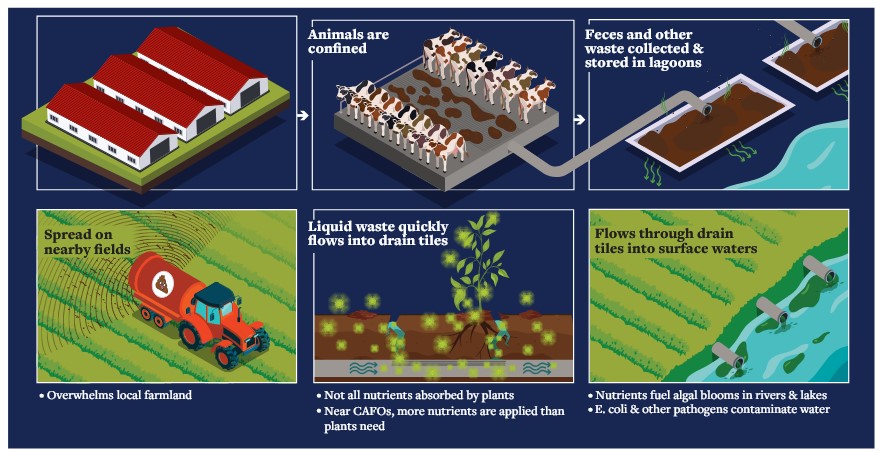June 18, 2025
Going to the Beach this Summer? Look Before You Dive In!
Bacterial contamination can close beaches across Great Lakes. Some pollution sources are getting worse, but digital monitoring tools are getting better. Learn how you can stay safe.
By Nancy Stoner, Senior Attorney
There is nothing like taking the family for a relaxing day at the beach on a hot summer day – and the Great Lakes region has lots of beautiful spots to explore. From the black rocks of Pebble Beach on Lake Superior in Minnesota to the sandy shores of Indiana Dunes National Seashore in Porter, Indiana, which is home to 16 native species of orchid, the beaches of the Great Lakes have something for everyone.
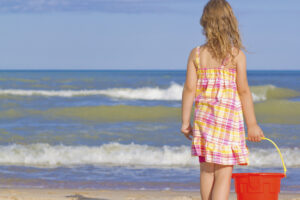 But before you dive in, check the water quality. Great Lakes beaches are monitored by governmental authorities and nonprofit organizations all summer for pollution that could make you, your family, and your pets sick. Waterborne illness is not fun. A day on the beach should not end with a night on the toilet – or in the emergency room.
But before you dive in, check the water quality. Great Lakes beaches are monitored by governmental authorities and nonprofit organizations all summer for pollution that could make you, your family, and your pets sick. Waterborne illness is not fun. A day on the beach should not end with a night on the toilet – or in the emergency room.
While some of the sources of water pollution are getting worse, the digital tools to monitor for pollution are getting better, so here’s how you can keep yourself and your family safe.
Bacteria at the Beach
E. coli is the most common form of bacterial contamination that affects beaches across the Great Lakes region. It is known to cause stomach illness, fever, diarrhea, and vomiting. Great Lakes beaches are protected by states based on the federal Environmental Protection Agency (EPA)’s recommended public health standards for fresh water. If bacteria levels exceed the E. coli standard, then authorities will close the beach until the levels come back down. Some beaches are monitored daily, some weekly, and some monthly, and the results are publicly available from individual states, the federal EPA, or from nonprofit organizations whose volunteers take and analyze samples through SwimGuide. Beach water monitoring data is also collected in the Beach Advisory and Closing Online Notification (BEACON) system, though states don’t always submit data consistently to BEACON.
According to data from the BEACON system, from May to September 2024, at least 256 Great Lakes beaches across Michigan, Indiana, Illinois, Ohio, Minnesota, and Wisconsin were either closed or issued contamination advisories due to E. coli contamination, totaling 2988 days. Of these beaches, 93 experienced double-digit days of closures or advisories, with Lakeview Beach in Lorain County, Ohio on Lake Erie, reaching 73 days. Illinois data was not reported to BEACON in 2024, but several beach closures occurred there as well. Wisconsin had the highest number of impacted beaches reported at 90, followed by Ohio (67), Michigan (62), Indiana (20), and Minnesota (17).
Where does this pollution come from?
Human and animal waste are the two main causes of both E.coli pollution and harmful algal outbreaks. This pollution can flow into Great Lakes waters from sewer systems, especially those that are designed to overflow when it rains, called combined sewer systems. According to US EPA, there are 158 communities which authorize raw sewage discharges from combined sewer systems into the Great Lakes Basin.
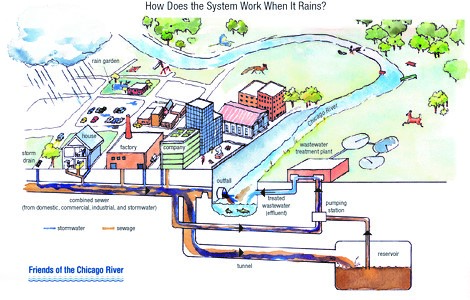
Illustration of how a Combined Sewer Overflow system works during the rain. Click to learn more from Friends of the Chicago River.
Chicago, Milwaukee, Grand Rapids, and Toledo are among the cities that have updated their sewer systems to reduce the amount of raw sewage that flows into the Great Lakes. Federal infrastructure funding has made many of these upgrades possible. While more work needs to be done, it has already been a huge success, which is why even urban beaches like Bradford Beach (Milwaukee) and North Avenue Beach (Chicago) are safe for swimming most of the time.
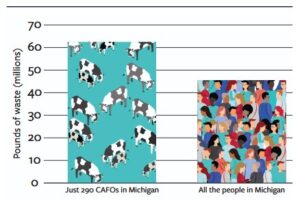
Michigan’s 290 permitted concentrated animal feeding operations produce 17 million pounds more waste per day than the state’s population of 10 million people. Click to learn more.
There is also a massive amount of manure generated by large animal feedlots, or concentrated animal feeding operations (CAFOs). Unlike human sewage, the manure produced by the thousands of industrial livestock facilities in the Great Lakes is not treated before it is dumped in a lagoon and eventually spread onto farm fields. All of this results in excess manure flowing into the rivers that discharge into the Great Lakes. Wildlife can also contribute to E. coli pollution. So pollution from either sewage or from animal waste can cause a beach to be closed for having too much E. coli to meet public health standards.
ELPC is working across multiple states in the Great Lakes region to improve clean water protections regarding animal sewage. We are working to better monitor and assess how the growing industry affects our water system, and fighting to hold large-scale polluters accountable for cleaning up their own mess. Learn more about our work here.
Climate Change Impacts
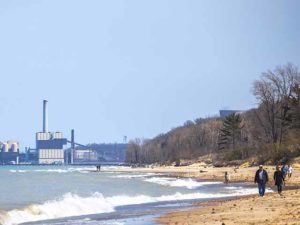
Michigan City, Indiana
Based on current long-range forecasts from the National Weather Service, the Great Lakes region is largely predicted to experience a warmer-than-average summer in 2025. Midwest scientists also anticipate above-normal precipitation in states south of the lakes, including Michigan, Illinois, Indiana, Kentucky, and Ohio.
Wetter weather, heavier storms, and more extreme precipitation patterns result in more sewage and manure in the beach water, meaning more closures and advisories. And, E.coli grows faster in warmer water as well, so if the water temperature goes up, so does your risk of getting sick.
How to Stay Safe at the Beach
Fortunately, there are resources available to check water quality at your local beaches and your favorite vacation spots. SwimGuide is an easy-to-use platform (and app) put together by nonprofit organizations whose volunteers take samples and gather data. They have data from beaches around the world, so it’s a handy resource for travelers too.
Here in the US, results are publicly available from the federal EPA, Beach Advisory and Closing Online Notification (BEACON) system, or from individual states. Michigan, Indiana, Illinois, Ohio, Minnesota, and Wisconsin each have their own beach monitoring and advisory systems. Check out these links before heading to the beach to make sure the coast is clear.
The BEACON system is supported by federal grant funding through a law called the BEACH Act, which passed unanimously in 2000, and has helped protect public health across the country for decades. Unfortunately, the Trump Administration has proposed ending all funding for beach water monitoring in the 2026 proposed budget now under consideration by Congress. Please contact your members of Congress to save beach monitoring here.


